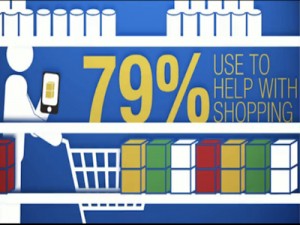 After the class about mobile marketing, I began thinking about my own electronic device usage. It came to the conclusion that I had my phone with me more than 90% of the time, while my laptop was only active for less than 10 hours a day. The reality is, my phone has become a part of my life, my sense of security. I can’t live without it, that is what is feels like. Although the idea of mobile marketing is still quite fresh to many businesses, the opportunities are endless. The small portable device capture consumers in all three aspects of the triangle—time, place, and need. This accessibility can potentially fill the gap of consumers’ behaviour to abandon shopping charts during their online shopping experience due to time constraints or other barriers that hinder consumers from completing their purchase.
After the class about mobile marketing, I began thinking about my own electronic device usage. It came to the conclusion that I had my phone with me more than 90% of the time, while my laptop was only active for less than 10 hours a day. The reality is, my phone has become a part of my life, my sense of security. I can’t live without it, that is what is feels like. Although the idea of mobile marketing is still quite fresh to many businesses, the opportunities are endless. The small portable device capture consumers in all three aspects of the triangle—time, place, and need. This accessibility can potentially fill the gap of consumers’ behaviour to abandon shopping charts during their online shopping experience due to time constraints or other barriers that hinder consumers from completing their purchase.
I see the use of mobile marketing used in two ways: (1) Expand marketing campaigns, such as a new product launch or a spontaneous promotion (2) Generate brand awareness by creating a simple, yet informational mobile interface that educates consumers on brand products and services.
Expanding marketing campaigns will entail seamless integration of the same marketing campaign that is user friendly on different interfaces. This will allow consumers to be in-the-know at all times about new product promotions, events, and contests hosted by companies. This will require more time in efforts to monitor and update multiple interfaces simultaneously.
Since mobile devices are screens are so micro compared to desktops, it is best to keep a clean and simple interface for mobile users. By creating a general brand mobile interface, it’ll allow consumers to explore products, product features, and learn more about what the company offers. A&W fast food restaurant does exactly this. They have created a simple, yet informative mobile interface for consumers to browse, explore, and gain better insight into their menu items and locations. While the A&W’s desktop website is dedicated to further product promotions. This approach requires less frequent updates to their mobile website, while still allowing consumers the option to easily navigate through their company website on mobile devices.
clean and simple interface for mobile users. By creating a general brand mobile interface, it’ll allow consumers to explore products, product features, and learn more about what the company offers. A&W fast food restaurant does exactly this. They have created a simple, yet informative mobile interface for consumers to browse, explore, and gain better insight into their menu items and locations. While the A&W’s desktop website is dedicated to further product promotions. This approach requires less frequent updates to their mobile website, while still allowing consumers the option to easily navigate through their company website on mobile devices.
Depending on company needs and goals, both mobile marketing incentives can help leverage brand name with the optimism of increased purchases.











